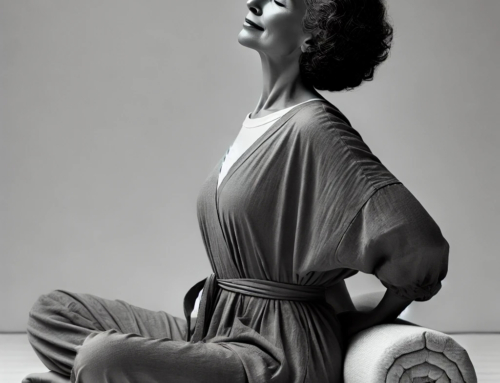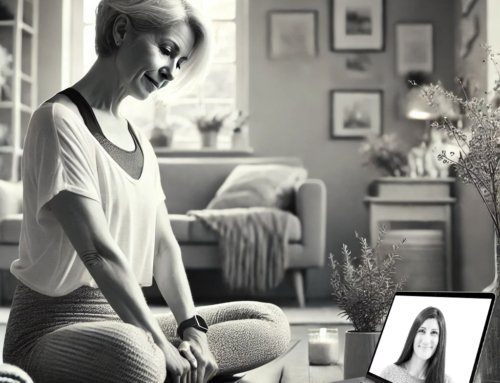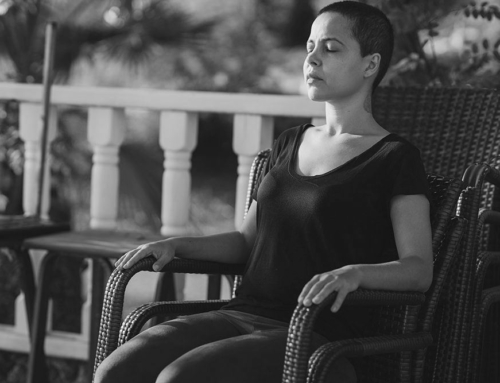This article originally appeared on pages 14-15 of the December 2013 issue of Natural Nutmeg
What is therapeutic yoga? It’s a combination of restorative yoga poses (poses where the body is supported with yoga props), gentle stretching, breath work, sound therapy and aromatherapy. It is designed to heal and restore the body and mind. It is said that the breath is the bridge that connects the body and mind. By allowing the breath to flow freely, we allow the life force to flow throughout the body, removing stuck energy, emotions or blocks buried within the cells, creating a space for healing.
Accepting Our Feelings
When someone is battling illness or dealing with an injury, they are usually feeling fear. Stress is fear manifested in the body. We all feel fear at times in our lives, but it seems that when we feel weak or overwhelmed, fear is more present. Yoga teaches us to confront those fears, rather than hide from them or stuff them down. We use stillness and our breath to gain insight about our feelings and experience them fully, without trying to change or run from them. With regular practice, we are able to recognize the potential of our bodies—however physically limited—to heal us and make us stronger. We also learn patience, with our practice and ultimately with ourselves.
When we begin to accept what we are feeling, whether it is fear or any other intense emotion, we view emotions as a natural part of our being and can embrace our true feelings moment by moment. We soon honor each emotion and realize that there is a reason for what we feel; there is a higher intelligence at work guiding us through life. It takes energy to avoid feeling emotion and there is a direct connection to feeling exhausted from this emotional suppression. When we release into feeling our emotions, tremendous energy is freed within, which the body can then channel into healing on a deep cellular level. When we allow the fullness of our true feelings to emerge and be felt, we move into greater balance in many aspects of our lives.
When we come into stillness, we hear the guidance of our inner voice and begin to restore. In the practice of therapeutic yoga, the student has time and space to relax into the postures, while listening to the wisdom which guides healing from within. The postures themselves help the body to release accumulated tension by deeply stretching the muscles and connective tissue. The process of deep breathing guides the student into a profound, relaxed, and stress-free state. As the body is cared for, new energy flows, which offers the body tremendous vitality for healing.
Let’s talk for a moment about the stress response. When we feel stress there is a release of stress hormones that:
- Constricts blood vessels
- Increases heart rate, blood pressure, breathing rate, bronchiole dilation, muscle tension, metabolic rate, and blood clotting
- Decreases digestive activity and insulin secretion
- Decrease of blood flow to active muscles and brain
- Narrowing of blood vessels (vasoconstriction) in skin, kidney, digestive track, and spleen
- Inhibition of energy storage (insulin resistance), glucose uptake to tissues (except active muscles and brain), and inhibition to reproductive and growth hormones
- Release of antidiuretic hormone (causing fluid retention, to sustain increased blood pressure)
- Initial increase in immune function, followed by suppression of immunity
- Brain arousal
- Pupil dilation
These symptoms are part of our “fight or flight” response, which is necessary when we are in danger or about to be eaten by a tiger. We use this stress to survive. The situation gets resolved quickly and the body returns back to balance. In today’s world, we are most likely not going to be eaten by a tiger. However, we find other stressful situations to activate the stress response.
Chronic Stress and Illness
Chronic stress keeps this response “on” and under this sustained stress, the body stays in high alert and the stress hormones keep on flowing. It’s the body’s adaption to chronic stress that makes us vulnerable to illness, disease and injury. In order to turn off this “fight or flight” stress response, we need to turn on our relaxation response.
Turning On Our Relaxation Response
As the body engages in the relaxation response, the condition of stress is replaced by the state of deep relaxation. By relaxing the body and mind through restorative poses, gentle stretching, and guided meditations and visualizations, we bring in a relaxation response where the body rests in a state of stillness. In this space, energy is directed to the processes of repair and rejuvenation, where natural healing takes place. Balance is restored and the body regains lost energy. Regular practice creates a reserve of energy where vitality, health, strength and creativity come from. We no longer feel depleted or trapped in the cycle of stress and tension. Natural and intuitive healing occurs.
Regular practice is most beneficial and I have personally experienced healing on a deep level. I’ve healed injuries to my neck and shoulders, hamstring, SI joint, knee, and found relief from chronic back pain. I suffered for almost a decade from chronic back pain after being in a terrifying car accident in 2001. I had cortisone injections and was prescribed pain pills, which only masked the pain and brought temporary relief on a superficial level. Therapeutic yoga created the space I needed for true, deep healing and actually eased the pain. I have been free from chronic back pain for over four years now and continue to ease injury and heal through my regular practice. I also use my practice to manage anxiety and depression.
Physical and Mental Transformation
When we journey inward to a place of stillness, we have tremendous potential for personal growth and transformation. Releasing physical holding patterns releases our mental patterns as well. Our experiences, thoughts and emotions are stored in the body, and through physical movement and release, we have the potential for deep emotional release, thereby restructuring our mental patterns. We create new connections in the mind and body so that patterns of tension and negativity—our ruts—are replaced by new grooves of relaxation and positivity. How we hold our bodies reflects not only how we feel, but also how we feel about ourselves. In changing our physical posture, yoga can have a profound effect on our emotional outlook as well.
Yoga is for Everyone
Yoga is unique for everyone and every single person can benefit from gentle and therapeutic yoga, no matter what age or physical limitation. Yoga teaches us to be true to our needs and ourselves. It teaches us to feel our experiences and to let them go; if we hold on, we create more stress and blocks that stunt our growth in life. It is only when we let the past go that we can work for a healthy future and invite in positivity and experience true happiness. Circumstances of life are often out of our control but how we react, what we think and what we feel are in our control. Greeting difficult situations with ease is our best defense against illness, injury and stress, and the relaxation response is our most natural way to heal.






[…] Heal your Body with Therapeutic Yoga […]